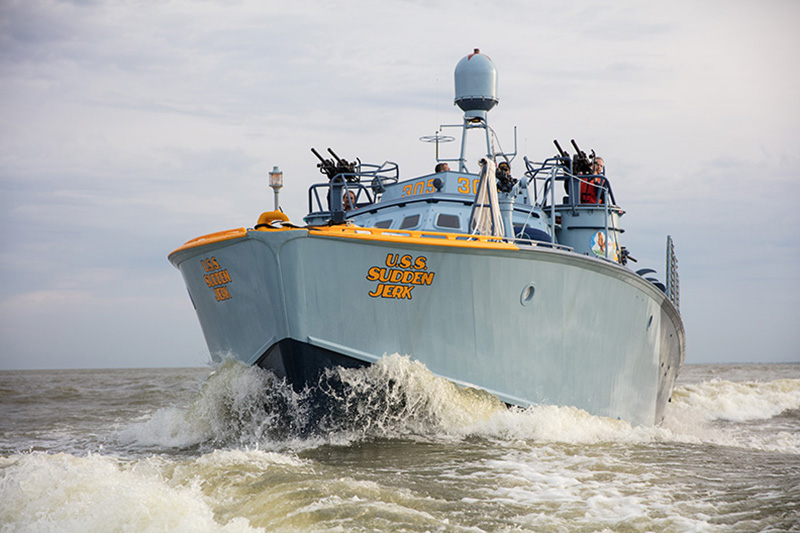The invitation arrived a month ago from The National WWII Museum in New Orleans. They wanted to know if I would be interested in riding on the museum’s restored WWII patrol torpedo boat Sudden Jerk before public rides are offered this spring. Do I want to ride on a real World War II PT boat, fully restored, as part of a group of media types? That would be a strong "yes."

PT-305 making its way through the streets of New Orleans in November 2016. Ken Hocke photo
I showed up at the PT-305’s new boathouse on Lake Ponchartrain in New Orleans Thursday morning and was immediately impressed with what I observed. The last time I saw the boat, back in November, it was on a barge owned by Canal Barge in the Mississippi River, having just paraded down the streets of the Warehouse District via transporter/crawler from the museum to the riverfront. It was an interesting trip, but talk about a fish out of water. Now it was actually in the water, in its new boathouse, all painted, polished and ready to impress.
I hopped aboard the 78'x20'8"x5'3" PT-305 for the first time, imaging what it must have been like for the sailors who actually manned the boat. I was aboard to go on an excursion. They came aboard knowing they were risking their lives. Still, it was cool — the torpedoes, machine guns, canons — all weapons I had used in my imagination as a boy growing up not far from the boathouse that was the new home of PT-305.
“People from all over the country have embraced this project,” Capt. George Benedetto, a licensed 100-ton master and pilot of the day’s cruise said standing next to the boat’s controls. “I’ve been with the project as a volunteer since the beginning. It’s been worth the effort, not just getting the boat back where it was but getting to know all the volunteers who have been so passionate about this project.
“Everything is the same as it was originally, except that we had to add a few electronics that the Coast Guard wanted,” said Benedetto. “Some of my favorite things about the boat are the way it sounds and the way it runs when she is up on step.”

World War II patrol torpedo boat PT-305 running in Lake Pontchartrain in New Orleans. Photo Courtesy of The National WWII Museum.
Fifteen minutes later, our group was taken to a room inside the boathouse for a seven-minute video about the history of the boat. Delivered in 1943, the PT-305 was assigned to Motor Torpedo Squadron 22. Built at Higgins Industries in New Orleans, the PT-305 got its name Sudden Jerk after a particularly hard landing soon after its delivery.
Based at Bastia on the island of Corsica, and later at St. Tropez in France, the PT crews hunted German ships, mostly at night, as the Allies pressed their way into southern Europe. (PT boats were also used in the Pacific.) The boats would launch their torpedoes then disappear into the night as the enemy returned fire. Powered by a trio of Packard W-14 M2500 gasoline engines, each burning 100-octane aviation gasoline to turn 1,500 hp on three shafts, the Higgins PT boats could sustain 27 knots and hit 41 knots at top end. A crew of up to 17 sailors manned four Mk 13 torpedoes launched from on deck, a single 40-mm and two 20-mm deck cannons, two twin and two single .50-caliber machine guns, and a 60-mm mortar.

Inside the PT-305 engine room. Photo courtesy National WWII Museum.
Sudden Jerk was sold as war surplus in 1948 and PT-305 wound up with commercial fisherman Frank Reis of Provincetown, Mass. Several owners later, the vessel ended its career as a battered Chesapeake Bay oyster boat — shortened by 13' sawn off its stern to escape Coast Guard regulations on vessels over 65' at the time. Finally, a volunteer group from Kemah, Texas, Defenders of America Naval Museum, rescued the boat in March 2001, hoping to restore it. Later realizing the restoration job was too big for the group, it reached out to the National WWII Museum for help. Over the next 10 years, the vessel underwent more than 120,000 hours of restoration work by 200 volunteers, in the museum’s glass-walled Kushner Restoration Pavilion and at the boathouse on Lake Pontchartrain.
After a two-minute safety video, I boarded the boat, put my floatation device on and sat across from the museum’s senior curator and restoration manager, Tom Czekanski. “It’s been a long time, but it’s finally happening. What surprises most people is that it’s all made of wood,” he said as we backed out of the boathouse. “We have room for 18 passengers and five crew. The crew is paid, partly because of insurance concerns. They said paid would be better” than volunteers.

Capt. George Benedetto giving instructions to the crew before PT-305 left the boathouse. Ken Hocke photo.
The boat moved out past the jetty and Benedetto gave the PT-305 some juice. There was no vibration or hesitation in the engines as they moved the boat up to a running speed of about 30 knots, but they were loud enough that you knew they were running. This is not a boat on a lake inside Disney World. Sudden Jerk was made to operate in a war zone. It’s as comfortable as the museum staff can make it, but you’ve got to remember what you’re riding on. To me, that’s what makes it exciting.
The boat ran about six miles, along the PT boats’ original delivery route in benign seas, circled around and headed back to the boathouse, about 35 minutes in all. Tough duty but I was up to it. The public experience will be closer to 90 minutes. But the ride won’t be cheap. It will cost people 12 and older $350, seniors, $305, and a tour only, $15.
Once back in the boathouse, I talked to Jack Wade III, a former volunteer, now a PT-305 motor machinist mate, after he climbed out of the engine room. “These engines are an aircraft derivative from World War I aircraft, a supercharged V-12. They burn 100-octane gasoline at around 87 or 88 gallons an hour,” he said. “If we increase the speed, maybe we get up to 100 gallons an hour, depends on the speed they want.
“Everything’s original with the addition of some sensors and monitoring equipment,” said Wade. “These engines have pistons the size of coffee cans and 90 to 100 pounds of oil pressure.”
I was packing up my gear when Candy Westfall, the project manager, came up to me and said, “Well, how was it?”
“I can be back tomorrow morning,” I said. She thought I was kidding.
My sincere thanks Candy Westfall, Michelle Moore, Bruce Miller, Capt. Benedetto and his crew and especially all the volunteers who brought PT-305 back to life.




